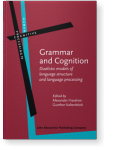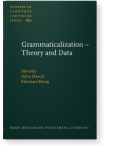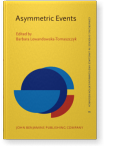Mitsuko Narita Izutsu
List of John Benjamins publications for which Mitsuko Narita Izutsu plays a role.
2023 Chapter 11. Highlighting beginning, end, or transition in-between: Topic-shift conceptions in English, Ainu, and Japanese Discourse Phenomena in Typological Perspective, Barotto, Alessandra and Simone Mattiola (eds.), pp. 295–336 | Chapter
This study presents a cross-linguistic analysis of episode- and topic-shift conceptions based on two types of spoken discourse (narrative and conversational) in English, Ainu, and Japanese. Markers of episode/topic-shift can serve to highlight different phases of episode/topic boundaries in… read more
2023 Chapter 6. The final-appendage construction in Japanese and Korean: To what extent is post-predicative position exploited in the two East Asian languages? Different Slants on Grammaticalization, Hancil, Sylvie and Vittorio Tantucci (eds.), pp. 147–175 | Chapter
Japanese and Korean are both predicate-final (OV) languages with relatively flexible constituent order. However, our analysis of parallel texts (Japanese novels and their Korean translations) demonstrates that the two languages differ in the exploitability of post-predicative position. Korean has… read more
2021 Chapter 3. Presentation followed by negotiation: Final pragmatic particle sequencing in Ainu Pragmatic Markers and Peripheries, Van Olmen, Daniël and Jolanta Šinkūnienė (eds.), pp. 77–110 | Chapter
This study explores the sequential pattern of sentence- or utterance-final pragmatic particles in Ainu, an indigenous language of Japan, and demonstrates that the particle sequences largely exhibit an ordering summarized as presentation followed by negotiation: a particle concerning the… read more
2020 Chapter 5. Dichotomous or continuous? Final particles and a dualistic conception of grammar Grammar and Cognition: Dualistic models of language structure and language processing, Haselow, Alexander and Gunther Kaltenböck (eds.), pp. 159–190 | Chapter
This article demonstrates that final particles (more broadly markers) in four East Asian languages (Japanese, Korean, Chinese, and Mongolian) and three West European languages (English, Spanish, and German) follow a similar semantic/discourse-functional ordering principle when they occur in… read more
2020 Chapter 5. Final or medial: Morphosyntactic and functional divergences in discourse particles of the same historical sources Information-Structural Perspectives on Discourse Particles, Modicom, Pierre-Yves and Olivier Duplâtre (eds.), pp. 135–160 | Chapter
Some Japanese final particles find their origins in the same historical sources as interjectional (or medial) particles, with the former occurring in sentence-final position while the latter in sentence-medial position. The two types of particles, though identical in form, are less likely to be… read more
2019 Why is Twitter so popular in Japan? Linguistic devices for monologization Internet Pragmatics 2:2, pp. 260–289 | Article
Across the countries of the world, Japan can rightly claim to be a great “Twitter nation” (Akimoto 2011). Japanese people like to tweet anytime and anywhere. Although the popularity of Twitter in Japan is often associated with the large information capacity of Japanese character sets (Wagner… read more
2018 Cross-varietal diversity in constructional entrenchment: The final-tag construction in Irish and American English New Trends in Grammaticalization and Language Change, Hancil, Sylvie, Tine Breban and José Vicente Lozano (eds.), pp. 381–430 | Chapter
The present study analyzes clauses with final tags as a construction, i.e., a symbolic form-meaning pairing, which is formulated as [[ANCHi FTj] ↔ [S conclude verbalization of propositioni with attitudej]] (ANCH: Anchor, FT: Final Tag, S: Speaker). The final-tag construction is observed in most… read more
2016 Temporal scenery: Experiential bases for deictic concepts of time in East Asian languages Conceptualizations of Time, Lewandowska-Tomaszczyk, Barbara (ed.), pp. 207–242 | Article
The present article analyzes the conceptual patterns of temporal deixis in Ainu,
Chinese, Japanese, Korean, and Ryukyuan. It demonstrates that Lakoff and
Johnson’s notions ‘moving time’ and ‘moving observer’ are more or less applicable
to the five East Asian languages but are not necessarily… read more
2016 Exaptation and adaptation: Two historical routes to final particles in Japanese Exaptation and Language Change, Norde, Muriel and Freek Van de Velde (eds.), pp. 377–401 | Article
This article shows that the final-particle development from coordinating conjunctions and that from subordinating conjunctions in Japanese can be best described as ‘adaptation after exaptation’ and ‘successive adaptations’, respectively. Whereas both types of developments are comparable in that… read more
2014 Truncation and backshift: Two pathways to sentence-final coordinating conjunctions Journal of Historical Pragmatics 15:1, pp. 62–92 | Article
This article deals with so-called sentence-final coordinating conjunctions in some dialectal varieties of English and Japanese. It emphasises that such final coordinating conjunctions derive from two syntactically different processes (“truncation” and “backshift”), and demonstrates that the final… read more
2014 “Final hanging but” in American English: Where a formal coordinator meets a functional subordinator Grammaticalization – Theory and Data, Hancil, Sylvie and Ekkehard König (eds.), pp. 257–286 | Article
Mulder and Thompson (2006, 2008) point out that the final hanging but ([X but]) developed from initial but (X [but Y]) through a sequence of formal reanalyses, and insightfully observe the functional and formal parallelism between the development of the hanging type of final but and the final… read more
2013 From discourse markers to modal/final particles: What the position reveals about the continuum Discourse Markers and Modal Particles: Categorization and description, Degand, Liesbeth, Bert Cornillie and Paola Pietrandrea (eds.), pp. 217–236 | Chapter
2012 Inclusivity and non-solidarity: Honorific pronominals in Ainu Pragmatics and Society 3:1, pp. 149–166 | Article
Some languages use first person inclusive plurals for second person reference. Such usage has often been associated with the notions of solidarity or lesser social distance. However, this line of explanation cannot provide an adequate account for the use of inclusives for second person honorific… read more
2011 What motivates an inference? The emergence of CONTRAST/CONCESSIVE from TEMPORAL/SPATIAL OVERLAP Motivation in Grammar and the Lexicon, Panther, Klaus-Uwe and Günter Radden (eds.), pp. 107–132 | Article
The present article proposes both theoretical and empirical explanations for the semantic shift from the meaning temporal/spatial overlap to the meaning contrast/concessive, observable across genetically and geographically unrelated languages (e.g. English while, Japanese -nagara). The shift… read more
2008 6. Notional asymmetry in syntactic symmetry: Connective and accessibility marker interactions Asymmetric Events, Lewandowska-Tomaszczyk, Barbara (ed.), pp. 121–134 | Article
The present paper argues that the distinction between symmetric- and asymmetric-event descriptions determines the pronominal reference in the conjoined structure “S1. discourse connective + S2.” with a pronoun in the S2. Symmetric-event descriptions presuppose an entity which does two things or to… read more
2008 Commitment to an implicit aspect of meaning: A notional differentiation between concessive connectives Commitment, De Brabanter, Philippe and Patrick Dendale (eds.), pp. 137–154 | Article
This paper argues that the notion of commitment can clarify the distinction between two Japanese concessive connectives -noni and -kedo: the former expresses a high degree and the latter a relatively low degree of speaker commitment to an assumption underlying the concessive meaning. This… read more















